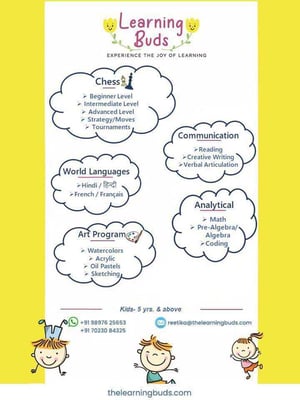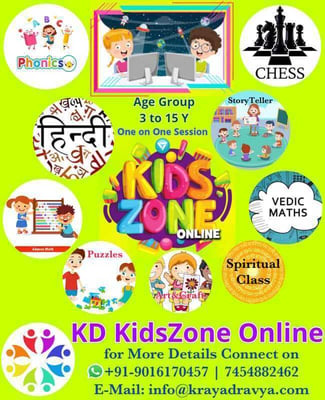Hindi classes for Kids - 45 options found
Hindi classes for children aged 2 to 15 offer numerous benef... Hindi classes for children aged 2 to 15 offer numerous benefits, including language acquisition, cognitive development, global perspective, career opportunities, personal development, and social skills enhancement. Through interactive activities, children learn Hindi language and culture, fostering bilingualism and cross-cultural understanding. Proficiency in Hindi opens doors to international opportunities and diverse career paths, while also boosting confidence and empathy. Starting at a young age, children develop linguistic abilities, cognitive skills, and cultural appreciation that prepare them for success in a globalized world, enriching their lives and broadening their perspectives. Read more
bliss eduacademy-tuition classes
the maths learning centre-lessons
the maths learning centre-lessons
tuitions n classes-tuition center
the learning brush-handwriting coursethe-learning-brush-
the maths learning centre-lessons
funscads-hindi learning
the maths learning centre-lessons
Advantages of Hindi Classes for Children Ages 2 to 15
Hindi classes offer children aged 2 to 15 a range of benefits, from language acquisition to cultural understanding and enhanced cognitive abilities. In this comprehensive guide, we'll explore the advantages of Hindi classes for children in this age range, potential limitations, and address common questions regarding its impact on brain development, personality development, and future career opportunities.
Introduction
Hindi classes provide children with the opportunity to learn the Hindi language, as well as explore Indian culture, traditions, and customs. These classes are designed to introduce children to the language through interactive and engaging activities, fostering a love for Hindi language and culture from a young age.
Advantages
-
Language Acquisition:
- Bilingualism: Learning Hindi at a young age allows children to become bilingual or multilingual, which has cognitive benefits and enhances communication skills.
- Cultural Understanding: Through learning the language, children gain insight into Indian culture, history, and traditions, fostering cross-cultural understanding and empathy.
-
Cognitive Development:
- Enhanced Brain Function: Learning a second language, such as Hindi, stimulates brain development and enhances cognitive abilities, including memory, attention, and problem-solving skills.
- Increased Creativity: Bilingual children often demonstrate enhanced creativity and divergent thinking, as they can draw upon different linguistic and cultural perspectives.
-
Global Perspective:
- International Opportunities: Proficiency in Hindi opens up opportunities for children to study, work, or travel in India, as well as pursue careers in international business, diplomacy, or academia.
- Cultural Exchange: Learning Hindi facilitates cultural exchange and fosters connections with Hindi-speaking communities around the world, promoting global citizenship and intercultural communication.
-
Career Opportunities:
- Job Market Advantage: In an increasingly globalized world, proficiency in Hindi can give children a competitive edge in the job market, particularly in industries such as technology, finance, tourism, and translation.
- Cultural Liaison: Bilingual individuals who are proficient in Hindi can serve as cultural liaisons or translators, bridging the gap between Hindi and non-Hindi speakers in various professional settings.
-
Personal Development:
- Confidence Building: Mastering a second language boosts children's confidence and self-esteem, as they gain a sense of accomplishment and pride in their linguistic abilities.
- Resilience: Learning Hindi requires persistence and resilience, as children navigate the challenges of language acquisition and overcome obstacles through practice and perseverance.
-
Social Skills Enhancement:
- Cross-Cultural Communication: Learning Hindi enables children to communicate with Hindi-speaking peers and adults, fostering friendships and cultural exchange opportunities.
- Empathy and Respect: Through exposure to Indian culture and values, children develop empathy, respect, and appreciation for diverse perspectives and ways of life.
Limitations
-
Time and Commitment:
- Long-Term Investment: Achieving proficiency in Hindi requires sustained effort and commitment over an extended period, which may be challenging for some children and their families.
- Balancing Priorities: Learning Hindi may compete with other academic or extracurricular activities, requiring children to manage their time effectively.
-
Resource Availability:
- Access to Quality Instruction: Not all communities may offer Hindi language classes for children, limiting access to quality instruction and resources for language learning.
- Cost of Materials: Acquiring Hindi language textbooks, workbooks, and other educational materials may incur additional expenses for families, particularly for those on a limited budget.
Common Questions
-
At What Age Should Children Start Learning Hindi?
- Children can start learning Hindi as early as preschool age, around 2 to 3 years old, through exposure to basic vocabulary, songs, and games. However, language acquisition is most effective when introduced in early childhood.
-
Is Hindi Difficult for English-Speaking Children to Learn?
- While Hindi has a different writing system and grammatical structure compared to English, it is considered manageable for English-speaking children to learn with consistent exposure, practice, and instruction.
-
What Career Paths Can Proficiency in Hindi Lead To?
- Proficiency in Hindi can lead to various career paths, including translation, interpretation, international business, diplomacy, tourism, education, technology, and academia, among others.
-
How Can Parents Support Hindi Language Learning at Home?
- Parents can support Hindi language learning at home by exposing children to Hindi media, such as books, cartoons, and music, practicing basic vocabulary and phrases together, and encouraging participation in cultural activities and events.
Conclusion
Hindi classes offer numerous advantages for children aged 2 to 15, including language acquisition, cognitive development, global perspective, career opportunities, personal development, and social skills enhancement. While there may be limitations related to time commitment and resource availability, the overall benefits of learning Hindi are significant. By providing children with the opportunity to learn a new language and explore a rich and vibrant culture, Hindi classes prepare them for success in an increasingly interconnected and multicultural world, enriching their lives and broadening their perspectives.
























